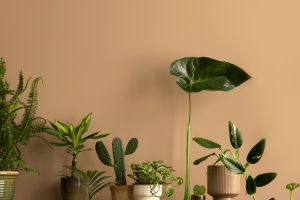
We all know having plants indoors is good for us—they make the space look better, lift our mood, and even help clean the air. But how exactly should we arrange them so they look great and stay healthy?
Today, we're sharing some plant placement tips that interior designers swear by to help us create the ultimate calming green space at home.
4 Golden Rules for Placing Indoor Plants
Unlike outdoor plants, indoor greenery needs more thoughtful care. Just placing them somewhere and watering them isn't enough. There are four things we need to think about:
1. Light
If your room is too dark, move the plants to a window at least once a week. Without enough light, leaves can droop or fall off, and flowering plants might not bloom at all.
2. Airflow
Plants thrive in fresh air. If our room is stuffy, it's easy for mold to grow in the pots. So make sure the area gets good ventilation.
3. Humidity
Some plants love moisture, and air conditioning can dry things out. Mist your plants regularly in dry spaces to keep them happy.
4. Temperature
Too hot or too cold? Both can slow a plant's growth. Different plants like different temps, so it's worth checking what your plant prefers.
Picking the Right Plant for Each Room
Ever bought a pretty plant only to watch it wither at home? That's probably because we didn't choose the right kind for our space. Here are some indoor plants that designers often recommend:
• Areca Palm
This one sways beautifully in the breeze and doesn't need much water. Perfect for big spaces like the living room.
• Fiddle Leaf Fig
With its upright branches and large, dark green leaves, it fits right into stylish indoor spaces.
• Hanging Plants (like Pothos, Ivy, and Pearl Grass)
These are easy to grow and look lovely cascading down walls or shelves. They also make ceilings feel taller.
• Monstera
Known for its split leaves, this bold plant adds character and a tropical touch—no wonder it's a favorite among designers!
Styling Plants Like a Designer
Some people just have a knack for plant styling, right? The secret lies in using design principles. Here are four pro tips we can try:
1. Match the plant size to your space
2. Choose pots that match your home's style
3. Mix solo plants with group arrangements for depth
4. Pick leaf shapes that suit the room's layout
For example, ST Design Studio likes to use different plant shapes and colors to build a layered look that blends beautifully with walls, floors, and furniture.
North Gull Studio uses bold, thick plants like Euphorbia to create a striking contrast to typical leafy plants. Depending on where you stand, the vibe of the room changes.
Upgrade Your Home with THESE Indoor Plant Display Tricks!
Video by Harli G
Using Light and Color to Your Advantage
Vision Design built a lush green wall on a bright balcony that contrasts beautifully with a red indoor wall.
EarSound Design uses bright green plants like palms, Boston ferns, fiddle leaf figs, and trailing greens to brighten up living rooms and kitchens.
FunChun Design won an award in 2019 for a project that perfectly combined plants with natural light, making a commercial space feel alive and welcoming.
No Light? No Problem!
Even if our homes don't get much sunlight, we don't have to give up on indoor plants. Just choose ones that tolerate low light, and you can still enjoy a fresh green corner. A great option? The unique and hardy Monstera—a plant that thrives indoors and adds instant life to common areas.


